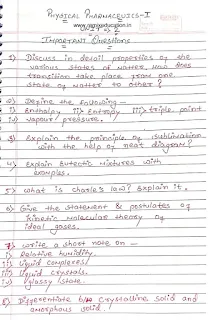Physical Pharmaceutics 1 (Unit:- 2): Hand Written Notes - States of Matter and Physical Properties
Dive into comprehensive hand-written notes for Physical Pharmaceutics 1, Unit 2, covering the fundamental characteristics and applications of various states of matter (gases, liquids, solids), gas laws, liquid crystals, polymorphism, and crucial physical properties of liquids. This essential B.Pharm resource is available for free download as a PDF or can be viewed online, providing detailed explanations vital for raw material testing, preformulation, and stability studies.
Keywords: Physical Pharmaceutics 1 Unit 2 notes, states of matter, gas laws, liquid crystals, polymorphism, amorphous solids, crystalline solids, physical properties of liquids, refractive index, dipole moment, optical activity, hand written notes pharmacy, download PDF pharmaceutics, B.Pharm study material, free notes, DuloMix, Sildes By DuloMix, pharmacy notes, view online, latent heat, boiling point, melting point, ideal gas, real gas, aerosol, inhalers, Bragg's law, crystal analysis, glass transition temperature, colligative property.
Exploring Physical Pharmaceutics 1 (Unit 2): States of Matter and Their Pharmaceutical Relevance
Unit 2 of Physical Pharmaceutics 1 provides a deep dive into the fascinating world of matter, exploring its various states – gases, liquids, and solids – along with the intriguing liquid crystalline state. Understanding the physical properties and transformations of these states is crucial for pharmaceutical scientists in designing, formulating, and testing drugs and dosage forms. This unit bridges theoretical physics with practical pharmaceutical applications, from raw material testing to predicting drug stability.
The Fundamental States of Matter: A Pharmaceutical Perspective
The unit begins by distinguishing between homogeneous and heterogeneous mixtures, and between physical and chemical changes, laying the groundwork for understanding material transformations. It then delves into the characteristics of each state:
- Gaseous State: Discusses ideal and real gases, gas laws (Boyle's, Charles's, Avogadro's), and the kinetic molecular model. Concepts like vapor pressure, critical temperature, and critical pressure are vital for understanding the behavior of propellants in aerosols and inhalers, which are significant pharmaceutical dosage forms. Deviations from ideal gas behavior are also explored, highlighting the importance of Van der Waals constants for real gases.
- Liquid State: Focuses on physical properties like boiling point, latent heat of vaporization, and the factors affecting them. The unit also introduces fascinating concepts like liquid crystals, their classification (nematic, smectic, cholesteric), and their growing pharmaceutical applications, particularly in drug delivery systems and analytical techniques.
- Solid State: This is perhaps the most extensive part, differentiating between crystalline and amorphous solids. Key concepts include crystal lattice, unit cells, elements of symmetry, and imperfections in crystals. Bragg's method for crystal analysis is explained, providing insights into the internal structure of crystalline materials. A major highlight is polymorphism – the ability of a solid material to exist in more than one crystalline or amorphous form. Understanding polymorphism is critical as different polymorphs of a drug can have drastically different solubilities, dissolution rates, and even bioavailability, impacting drug efficacy and safety. The concept of glass transition temperature and its significance for amorphous solids is also covered, influencing stability and processability.
Exploring Physical Properties of Liquids and Their Pharmaceutical Applications
Beyond the states themselves, the unit emphasizes the measurable physical properties of substances, particularly liquids, and their utility in pharmacy. These include:
- Refractive Index: A constitutive property related to the bending of light, used for identification and purity checks of liquids and solutions. Molar refraction helps elucidate molecular structure.
- Optical Activity: The ability of chiral molecules to rotate plane-polarized light. Specific rotation and molar rotation are critical parameters for characterizing optically active drugs and intermediates, especially in quality control. The polarimeter, an instrument for measuring optical rotation, is thoroughly discussed.
- Dipole Moment: An additive and constitutive property that quantifies the polarity of a molecule, revealing insights into its molecular structure and intermolecular interactions. It's crucial for understanding drug-receptor binding and solvent interactions.
- Dielectric Constant: Reflects a solvent's ability to reduce the force between charged particles, influencing the solubility of ionic compounds.
- Colligative Properties: Though briefly mentioned, these properties (like osmotic pressure, vapor pressure lowering, boiling point elevation, freezing point depression) are fundamental to understanding solutions, especially in relation to isotonicity and cryopreservation in pharmaceutical preparations.
Significance in Pharmaceutical Development
The knowledge gained from this unit has direct applications in various pharmaceutical fields:
- Raw Material Testing: Identifying and ensuring the purity of excipients and active pharmaceutical ingredients (APIs) through physical property measurements.
- Preformulation Studies: Characterizing the physical form (crystalline vs. amorphous), polymorphism, and thermal behavior of APIs to guide formulation development.
- Formulation Design: Selecting appropriate solvents, excipients, and processing conditions based on the physical properties of ingredients. For instance, understanding glass transition temperature is vital for solid dosage forms and amorphous drug stability.
- Stability Studies: Predicting and monitoring the physical stability of dosage forms, especially concerning phase transitions (e.g., polymorphic transformations) and changes in physical properties over time.
- Drug Delivery Systems: Designing novel systems like aerosols, inhalers, and liquid crystal-based formulations.
In essence, Unit 2 equips pharmacy students with a profound understanding of the physical world at a molecular level, enabling them to make informed decisions throughout the drug development pipeline. The intricate details of states of matter and their properties are not mere academic curiosities but essential tools for ensuring the safety, efficacy, and quality of pharmaceutical products.
Info!
If you are the copyright owner of this document and want to report it, please visit the copyright infringement notice page to submit a report.

